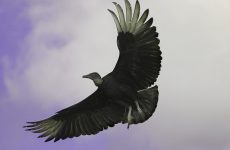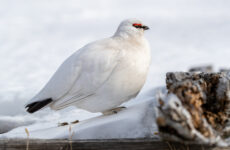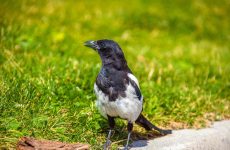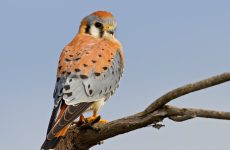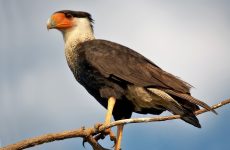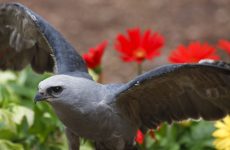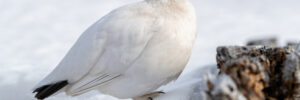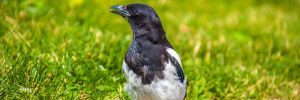These are the most common birds spotted in Quebec in winter, whether out walking or in your backyard.
So what are you waiting for? How many have you spotted?
25 Common Winter Birds Quebec
1. Black-capped Chickadee
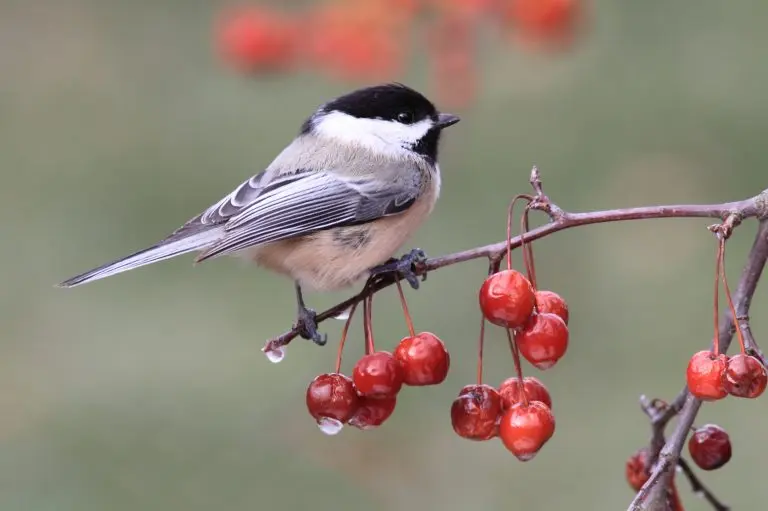
The Black-capped Chickadee is a cute bird with a big round head and tiny body. These birds will happily feed at backyard feeders and investigate everything, including you!
They have black caps and beaks, white cheeks, and are gray on the back, wings, and tail.
- Poecile atricapillus
- Length: 4.7-5.9 in (12-15 cm)
- Weight: 0.3-0.5 oz (9-14 g)
- Wingspan: 6.3-8.3 in (16-21 cm)
Black-capped Chickadees do not migrate and can be spotted in the northern half of the US and Canada.
You can find them in forests, open woods, and parks. Black-capped Chickadees eat seeds, berries and insects, spiders, and suet.
Black-capped Chickadee Call/Song:
Attract Black-capped Chickadees to your backyard with suet, sunflower seeds, and peanuts or peanut butter. They will even feed from your hand and are often one of the first birds to discover new feeders. They will also use nest boxes, especially if you fill them with wood shavings.
2. American Crow
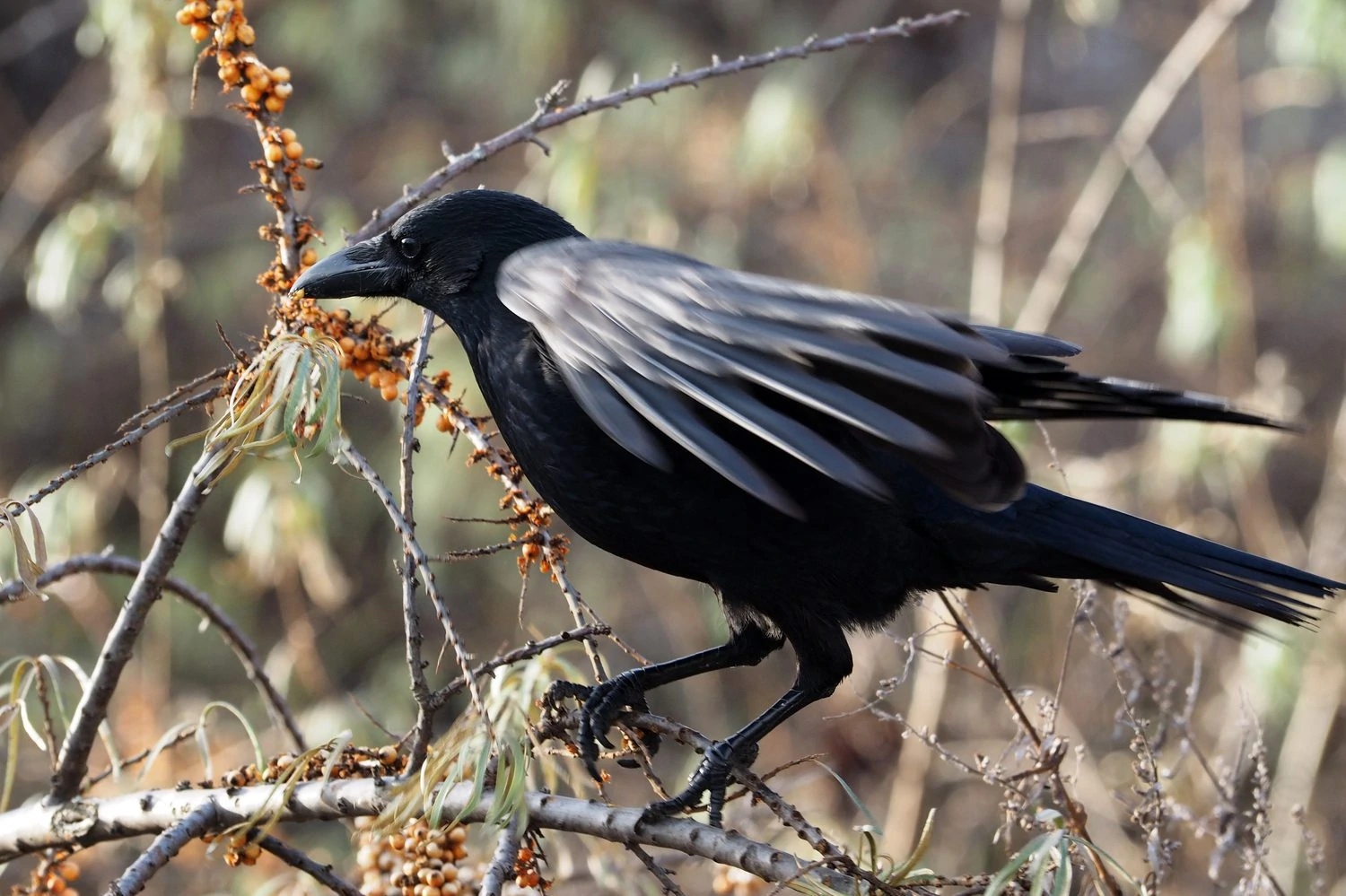
American crows are large all-black birds that make a hoarse, cawing sound.
- Corvus brachyrhynchos
- Length: 15.8-20.9 in (40-53 cm)
- Weight: 11.2-21.9 oz (316-620 g)
- Wingspan: 33.5-39.4 in (85-100 cm)
American Crows are residents all year in most of the lower 48 and the Pacific Coast in Canada and Alaska. Those that breed in Canada and the northern Midwest migrate south for winter.
They are common birds found in most habitats, including treetops, woods, fields, beaches, or towns.
They eat most things and usually feed on the ground, eating earthworms, insects, seeds, and fruit. They also eat fish, young turtles, mussels, and clams and will even eat eggs and nestlings of many species of birds.
In winter, American Crows gather in large numbers of up to two million crows to sleep in noisy communal roosts.
American Crow Call:
Attract American Crows to your backyard by scattering peanuts, but they can become a nuisance as they are attracted by garbage or pet food if left out.
3. Blue Jay
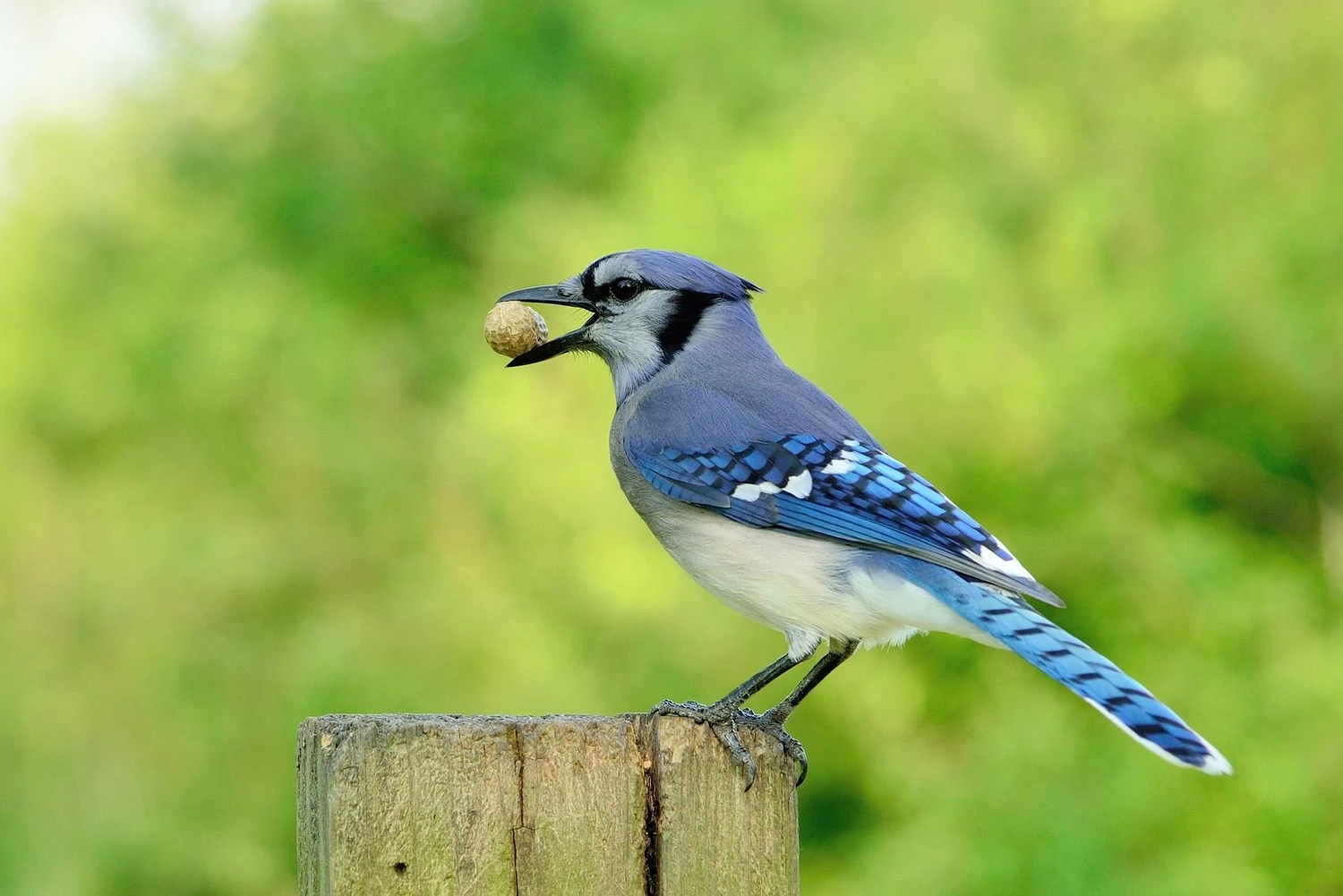
Blue Jays are common large songbirds with a blue upright crest, blue and black backs, and white undersides.
- Cyanocitta cristata
- Length: 9.8-11.8 in (25-30 cm)
- Weight: 2.5-3.5 oz (70-100 g)
- Wingspan: 13.4-16.9 in (34-43 cm)
Blue Jays live in eastern US states and Southern Canada all year. Some birds will migrate west for winter but not very frequently.
They are noisy birds that travel in family groups eating acorns when available. They can be found in forests, mainly near oak, as they eat acorns. They can also be found in backyards near feeders. As well as acorns, they eat insects, nuts and seeds, and grain. They may also take eggs from nests or take nestlings.
Blue Jay Call:
Blue Jays are large birds and prefer to fly in, grab a peanut or sunflower seed and take it away to feed. They prefer platform or tray feeders to make it easy to make a quick exit.
Attract Blue Jays to your backyard with peanuts, sunflower seeds, and suet. They prefer these on open tray feeders or hopper feeders on a post. They will also enjoy a birdbath.
4. Downy Woodpecker
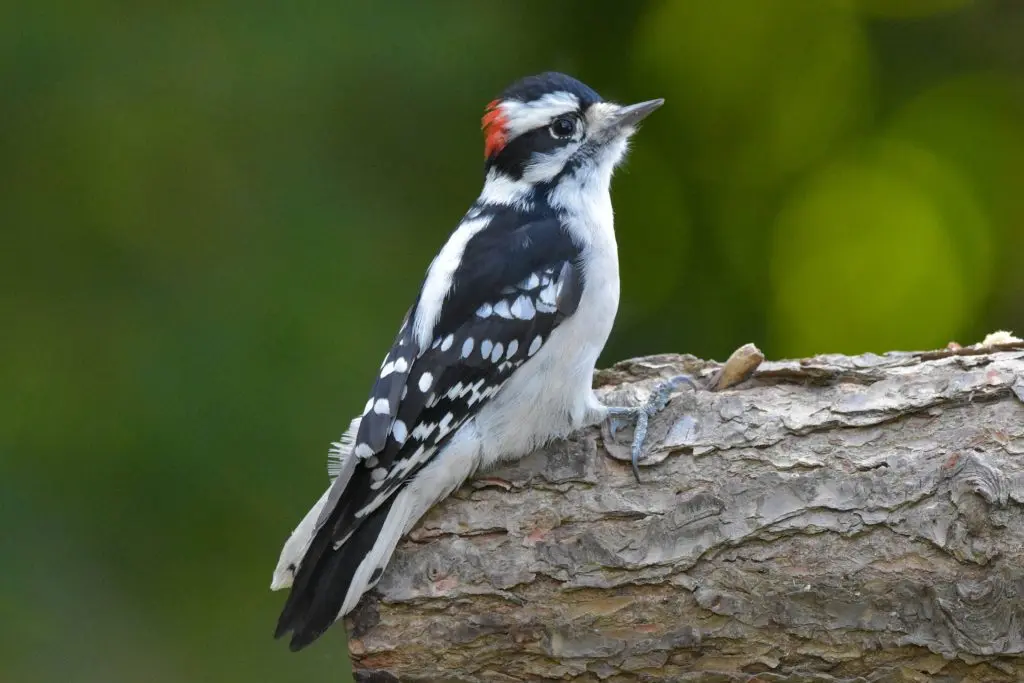
Downy Woodpeckers are small birds that are common at backyard feeders. They are often mixed in with other birds, such as chickadees and nuthatches.
They have black and white coloring with a red patch at the back of their heads. They look similar to the Hairy Woodpecker but smaller.
- Dryobates pubescens
- Length: 5.5-6.7 in (14-17 cm)
- Weight: 0.7-1.0 oz (21-28 g)
- Wingspan: 9.8-11.8 in (25-30 cm)
Downy Woodpeckers do not migrate and can be spotted in most states and provinces, except the north of Canada.
You can find Downy woodpeckers in woodlots, along streams, city parks, and backyards, and they eat mainly insects and beetle larvae but also berries, acorns, and grains.
Downy Woodpecker Call:
Attract Downy Woodpeckers to your backyard with their favorite treat of suet, but they will also eat black oil sunflower seeds, millet, and peanuts on platform feeders.
5. Hairy Woodpecker
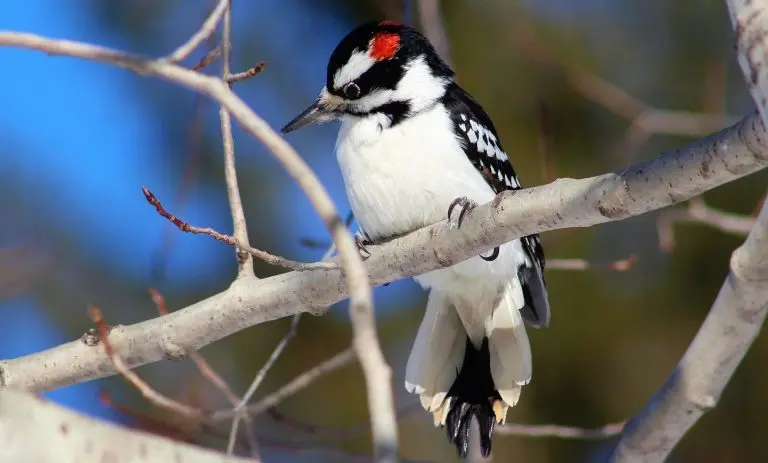
Hairy Woodpeckers are medium-sized woodpeckers with a black and white pattern and a large white patch on their backs. The males have a flash of red towards the back of their heads.
They are visually similar to Downy Woodpeckers but larger and with longer bills. As they are often found in the same areas, it is hard to tell them apart if they are not near each other.
- Dryobates villosus
- Length: 7.1-10.2 in (18-26 cm)
- Weight: 1.4-3.4 oz (40-95 g)
- Wingspan: 13.0-16.1 in (33-41 cm)
Hairy Woodpeckers do not migrate and live in all US states and Canada, except the far north of Canada.
You can find Hairy Woodpeckers in woodlands on trunks or main branches of large trees, but they are also found in a wide variety of habitats, including woodlots, parks, and cemeteries. Hairy Woodpeckers’ diet is mostly insects.
Hairy Woodpecker Call/drumming:
Attract Hairy Woodpeckers to your backyard with suet feeders.
6. European Starling
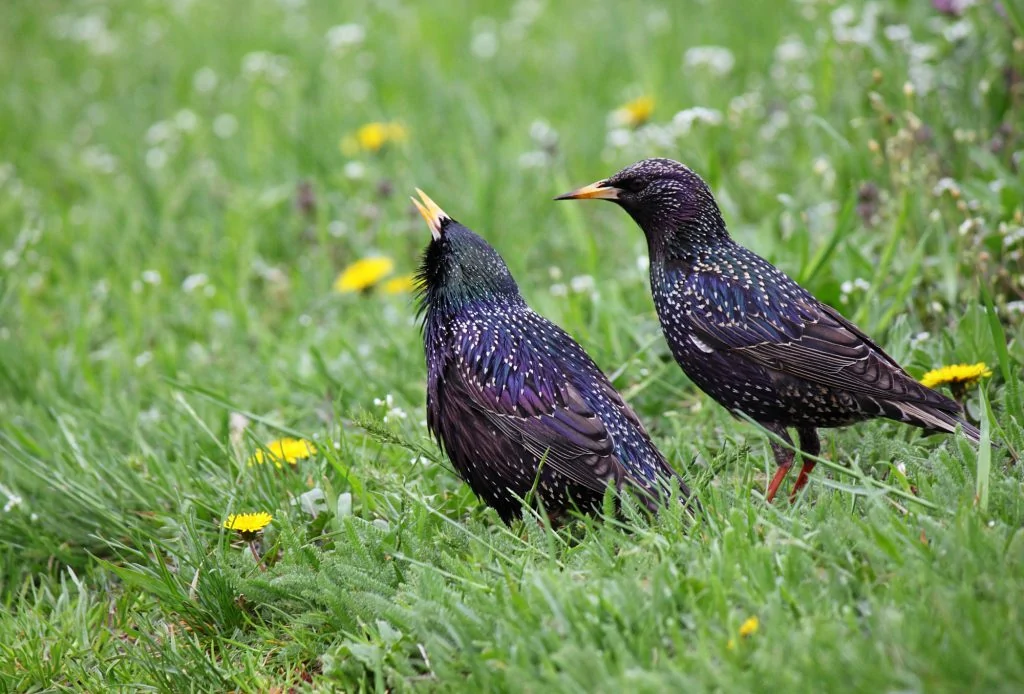
European Starlings are not native but are now one of the most numerous songbirds. They are stocky black birds with iridescent purple, green, and blue tones.
- Sturnus vulgaris
- Length: 7.9-9.1 in (20-23 cm)
- Weight: 2.1-3.4 oz (60-96 g)
- Wingspan: 12.2-15.8 in (31-40 cm)
European Starlings live in all of North America, except the north of Canada and Alaska.
They are considered a pest by some due to their aggressive behavior. These birds fly in large, noisy flocks and can be seen perched in groups on the top of trees or flying over fields.
European Starling Calls:
Starlings predominantly eat insects, including beetles, flies and caterpillars, earthworms, and spiders. However, they also eat fruit, including cherries, holly berries, mulberries, Virginia Creeper, sumac, blackberries, and grains and seeds.
Attract European Starlings to your backyard feeders with black oil sunflower seeds, suet, cracked corn, and peanuts.
7. Mourning Dove
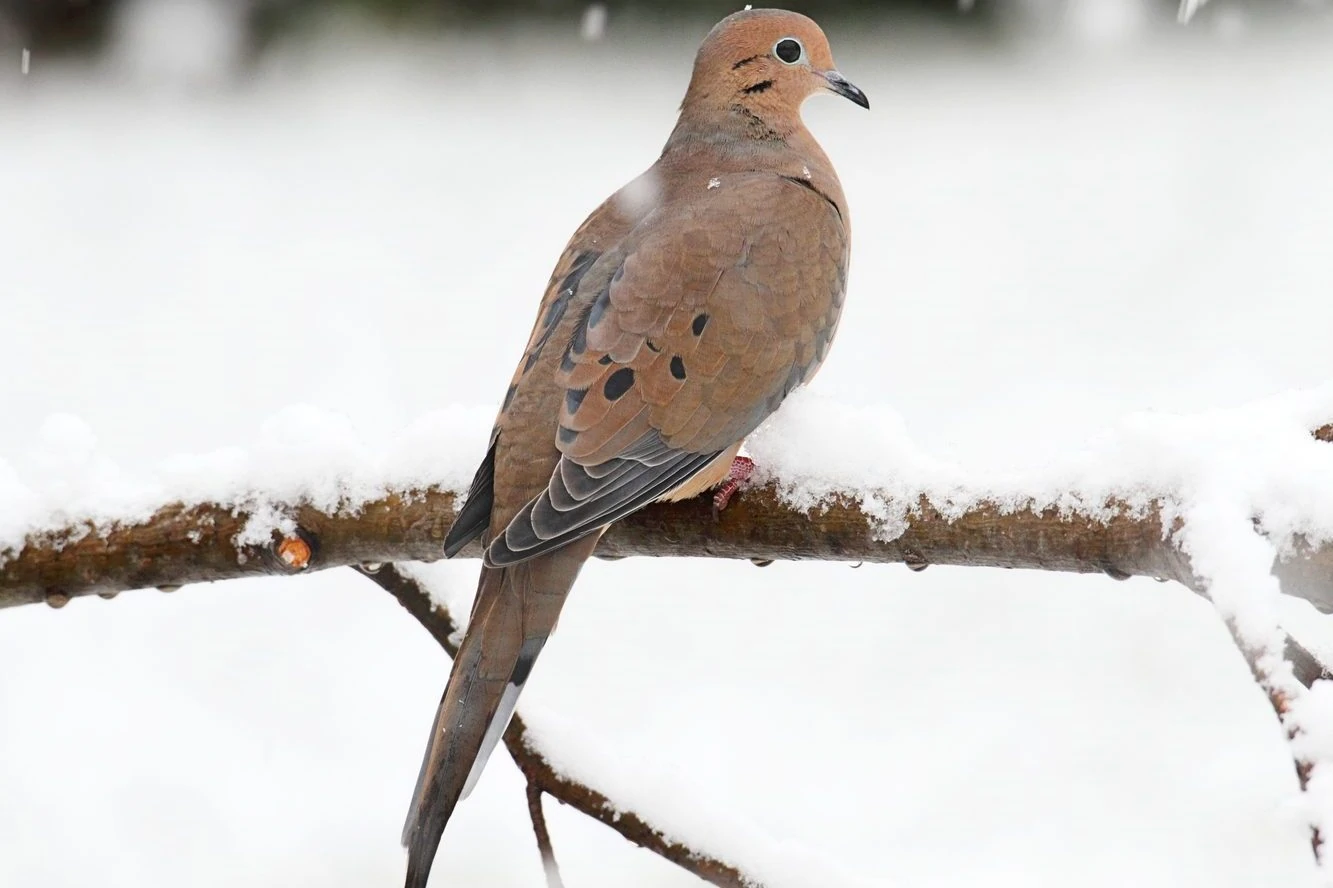
Mourning Doves are graceful small-headed birds with plump bodies and long tails. They are a soft brown color with black spots on the wings. Males are slightly heavier than females.
- Zenaida macroura
- Length: 9.1-13.4 in (23-34 cm)
- Weight: 3.0 -6.0 oz (96-170 g)
- Wingspan: 17.7 in (45 cm)
Mourning Doves are common over all of the lower 48 all year but may migrate after breeding from the north of the Midwest and southern Canada.
Mourning Doves can be seen perching on telephone wires and foraging for seeds on the ground in grasslands, fields, and backyards. They can also be found in open areas or woodland edges.
Mourning Dove call:
Attract Mourning Doves to your backyard by scattering millet on the ground or platform feeders. They will also eat black sunflower seeds, nyjer, cracked corn, and peanut hearts.
8. White-breasted Nuthatch
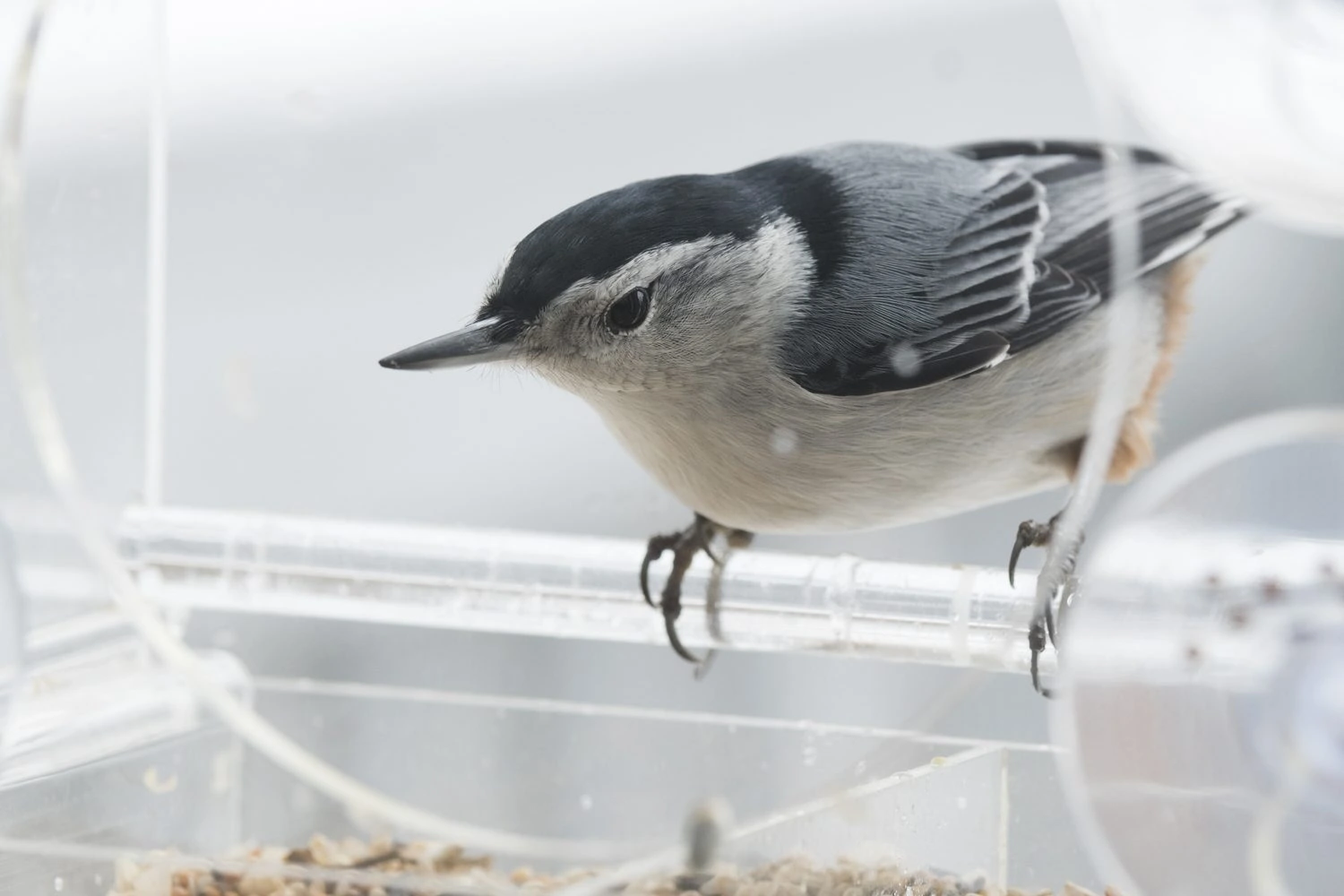
White-breasted Nuthatches are active little birds that are gray-blue on the back and white on the face and belly, with a black cap. They will often have a chestnut color on the lower belly and under the tail.
- Sitta carolinensis
- Length: 5.1-5.5 in (13-14 cm)
- Weight: 0.6-1.1 oz (18-30 g)
- Wingspan: 7.9-10.6 in (20-27 cm)
White-breasted Nuthatches live all year in the US and southern Canada.
You can find White-breasted Nuthatches in deciduous forests, woodland edges, parks, and yards with trees or at feeders. They mainly eat insects, including beetles and their larvae, caterpillars, ants, and also spiders.
White-breasted Nuthatches also eat seeds and nuts, including acorns, hawthorns, sunflower seeds, and sometimes corn crops. They jam large nuts and acorns into tree bark and then whack them with their bills to open or ‘hatch’ them to get the seed out.
White-breasted Nutcracker Call:
Attract White-breasted Nuthatches to your backyard with sunflower seeds and peanuts on tube feeders or suet feeders.
9. American Goldfinch
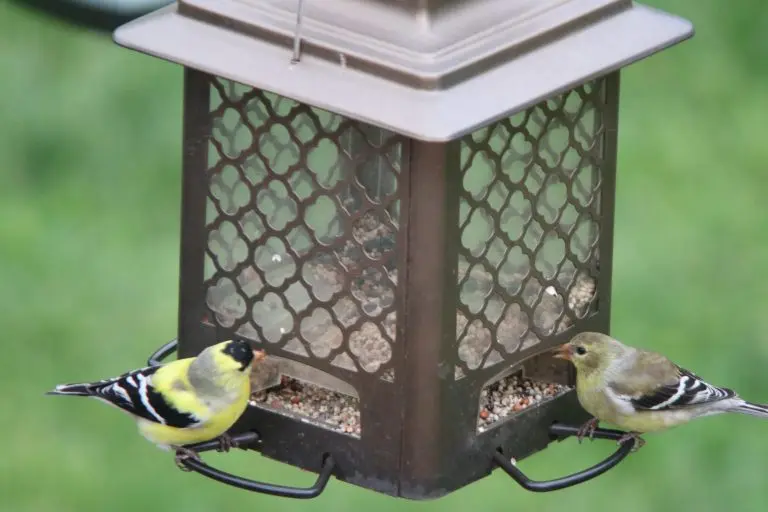
American Goldfinches are popular birds with the males’ bright yellow and black coloring in spring. The females are duller brown, as are males in winter.
- Spinus tristis
- Length: 4.3-5.1 in (11-13 cm)
- Weight: 0.4-0.7 oz (11-20 g)
- Wingspan: 7.5-8.7 in (19-22 cm)
American Goldfinches can be found in most of North America and are usually resident all year. However, those that breed in Canada and the Midwest migrate to southern US States for winter.
They can be found in weedy fields and overgrown areas foraging for sunflower, thistle, and aster plants. They are also common in suburbs, parks, and backyards.
American Goldfinch Song:
Attract American Goldfinches to your backyard by planting thistles and milkweed. They will visit most bird feeders and prefer sunflower seed and nyjer seed.
10. Common Raven
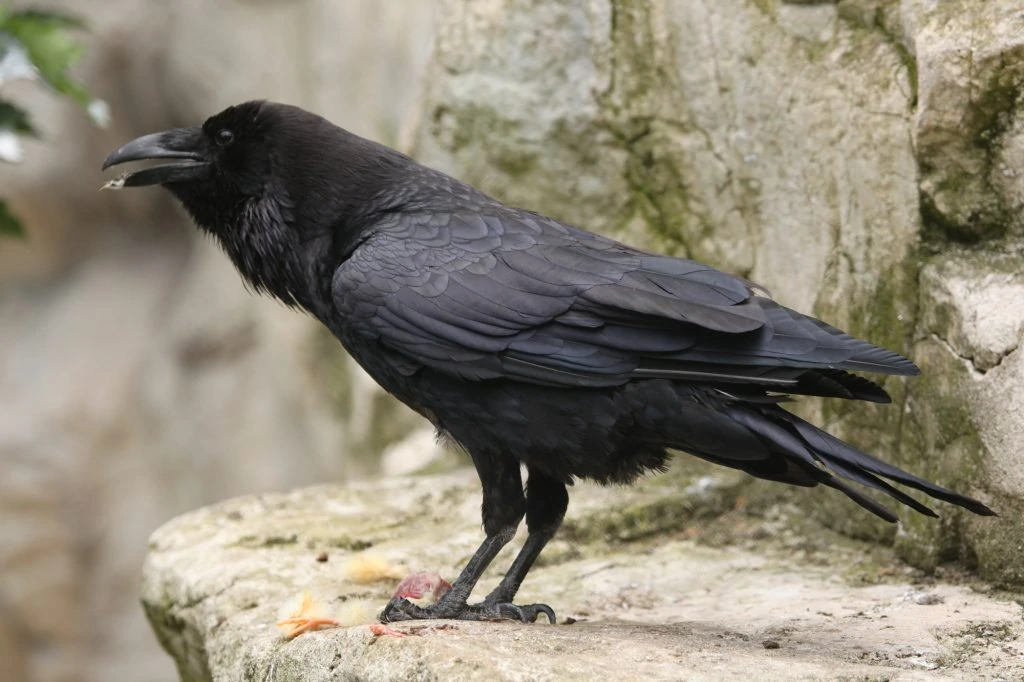
Common Ravens are thought to be one of the smartest and definitely one of the largest species in the songbird family. They have shaggy throat feathers, large black beaks, and wedge-shaped tails.
- Corvus corax
- Length: 22.1-27.2 in (56-69 cm)
- Weight: 24.3-57.3 oz (689-1625 g)
- Wingspan: 45.7-46.5 in (116-118 cm)
Common Ravens are resident in Canada, western US states, northeastern US states, Mexico, and northern Central America. They are not found in the Great Plains or eastern US states.
You can find Common Ravens in most places, and they especially follow humans. Forests, beaches, fields, grasslands are all places to find them and rural human areas. They are not common in towns and cities as American Crows take over.
Not known as picky eaters, Common Ravens will eat most things, including any small animals, eggs and nestlings, plus insects and fish. Human rubbish and pet food
Common Raven sounds: Mostly croaks and harsh calls
Fun Fact: Common Ravens in Canada weigh up to 60% more than those in California.
11. Dark-eyed Junco
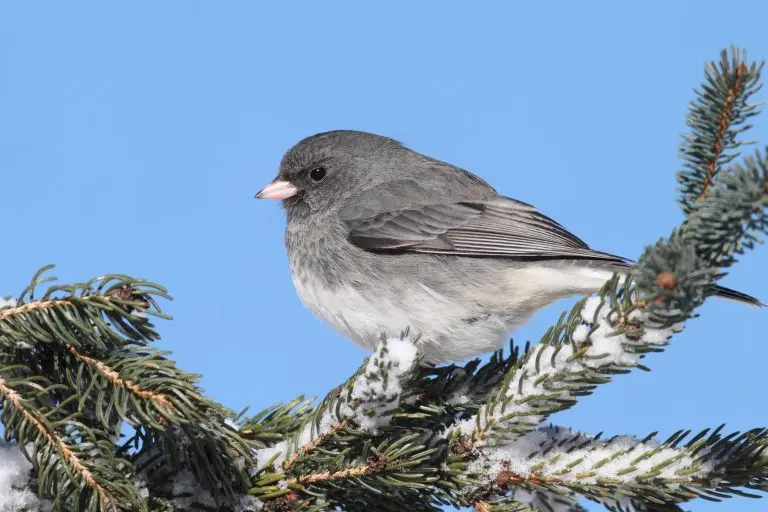
Dark-eyed Juncos are sparrows that are different colors depending on the state. They are generally slate-colored in the east and black, white, and brown in the west.
- Junco hyemalis
- Length: 5.5-6.3 in (14-16 cm)
- Weight: 0.6-1.1 oz (18-30 g)
- Wingspan: 7.1-9.8 in (18-25 cm)
Dark-eyed Juncos remain resident all year in northeastern and western US states and the Appalachian Mountains. Those that breed in Canada and Alaska migrate south in winter to the United States.
They can be found in open and partially wooded areas, often on the ground, and are common across the continent.
Dark-eyed Junco Song:
Attract Dark-eyed Juncos to backyard feeders with a variety of seeds such as black oil sunflower seeds, nyjer, cracked corn, millet, and peanuts. Platform feeders or scattered on the ground are best.
12. Rock Pigeon
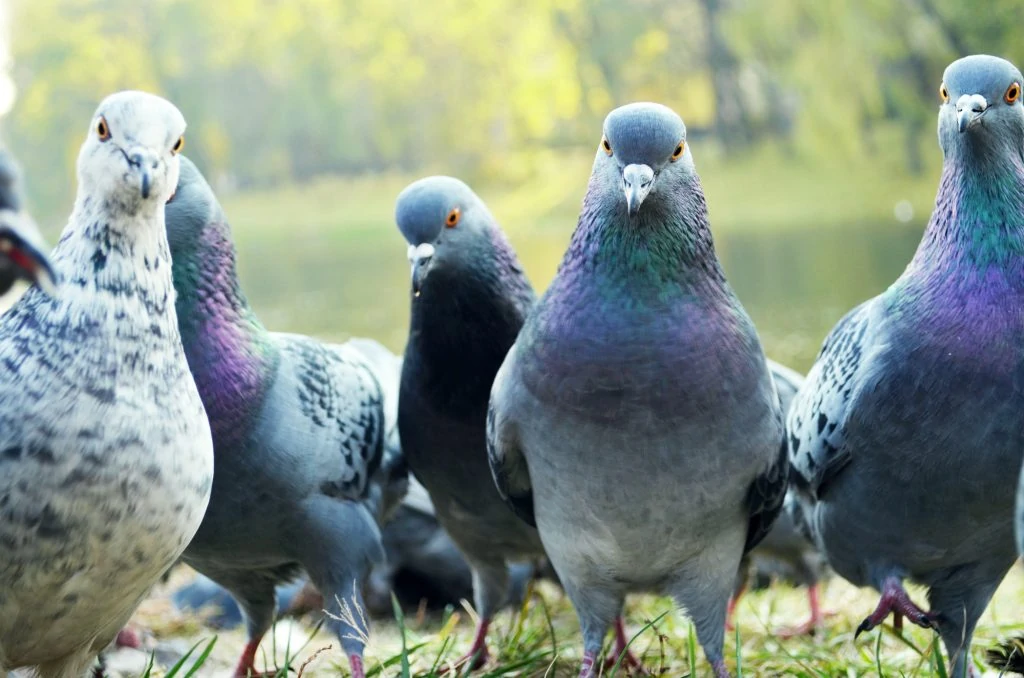
Rock Pigeons are well recognized around towns and parks and are usually blueish gray with two black bands on the wing and black on the tail tip. They have iridescent throat feathers and orange eyes.
However, they can also be white, spotted, or red.
- Columba livia
- Length: 11.8-14.2 in (30-36 cm)
- Weight: 9.3-13.4 oz (265-380 g)
- Wingspan: 19.7-26.4 in (50-67 cm)
Rock Pigeons do not migrate and can be found in all US states, southern Canada, and the Pacific Coast to Alaska.
You can find Rock Pigeons in cities, parks, and backyards, especially if there is birdseed on the ground. Some cities have ordinances against feeding pigeons as they are considered pests.
Rock Pigeon Call:
Fun Fact: Rock Pigeons have an amazing ability to find their way home using the earth’s magnetic field.
13. Common Redpoll
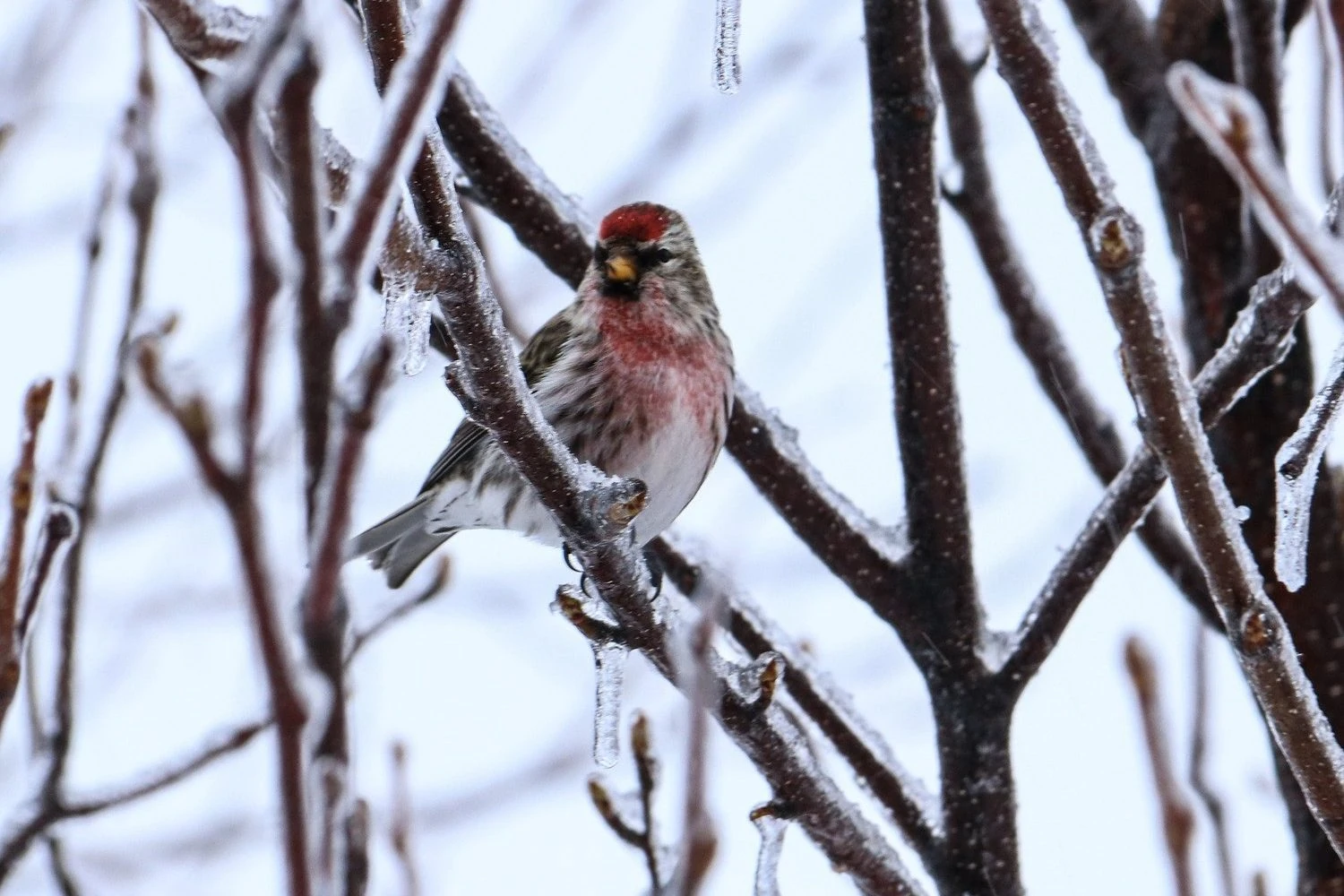
Common Redpolls are small and have red foreheads, and are brown and white streaked over the rest of their bodies. Males also have pink breasts, but females do not. They have small bills for finch and a short notched tail.
- Acanthis flammea
- Length: 4.7-5.5 in (12-14 cm)
- Weight: 0.4-0.7 oz (11-20 g)
- Wingspan: 7.5-8.7 in (19-22 cm)
Common Redpolls breed in artic in Canada and spend the winter in the rest of Canada and northern US states and less frequently in central US states.
In winter, they will sometimes tunnel into the snow to stay warm during the night. They can eat up to 42% of their body mass every day and can store up to 2 grams of seeds in a stretchy park of their esophagus.
You can find Common Redpolls in weedy fields or feeding on catkins in trees, but they will also come to feeders for small seeds such as nyjer seeds or thistle.
Common Redpoll Song:
Attract Common Redpolls to your backyard by feeding them nyjer seeds and shelled sunflower seeds.
Fun Fact: Common Redpolls can survive temperatures of -65 Fahrenheit without freezing to death. They add around 30% more feathers to stay warm.
14. Northern Cardinal
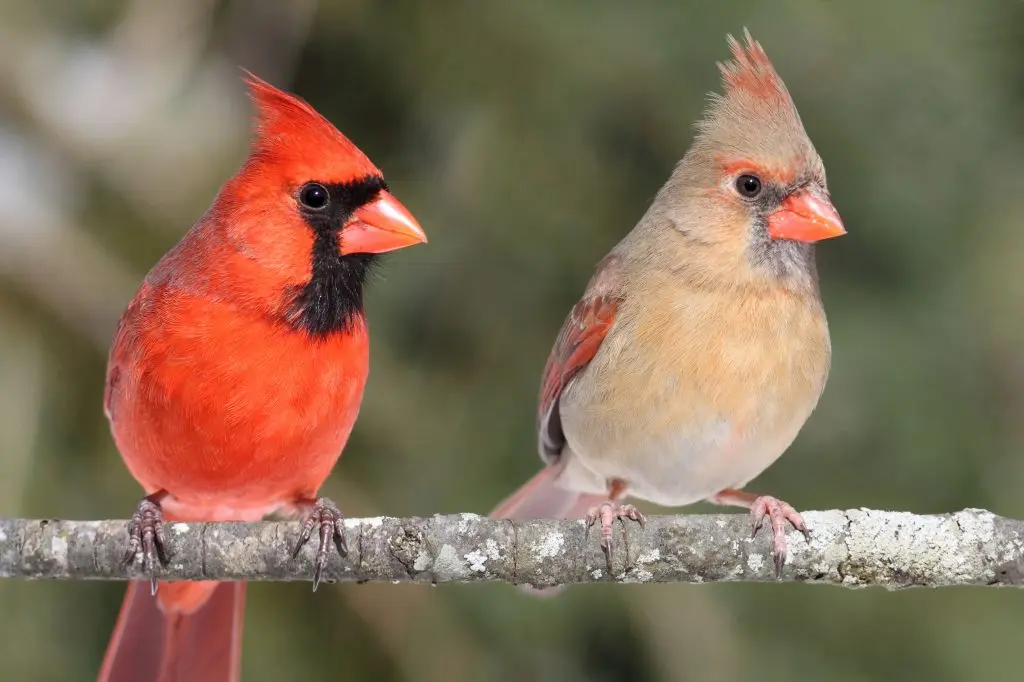
The bright red male Northern Cardinal with black around their faces is an incredible sight, especially against a white winter background. They also have red crests and beaks.
Females are also a little showy with their brown coloring, sharp brown crest, red highlights, and red beaks.
- Cardinalis cardinalis
- Length: 8.3-9.1 in (21-23 cm)
- Weight: 1.5-1.7 oz (42-48 g)
- Wingspan: 9.8-12.2 in (25-31 cm)
Northern Cardinals live in the Eastern half of the US and some states in the south as far west as Arizona.
You can find Northern Cardinals in dense vegetation foraging for seeds, fruit, and insects. Northern Cardinals will sometimes attack their own reflection during the breeding season as they obsessively defend their territories.
Northern Cardinal Song:
Northern Cardinal Call:
Attract Northern Cardinals to your backyard with feeders full of sunflower seeds, peanut hearts, millet, and milo. They will feed from large tube feeders, hoppers, platform feeders, or food scattered on the ground.
15. House Sparrow
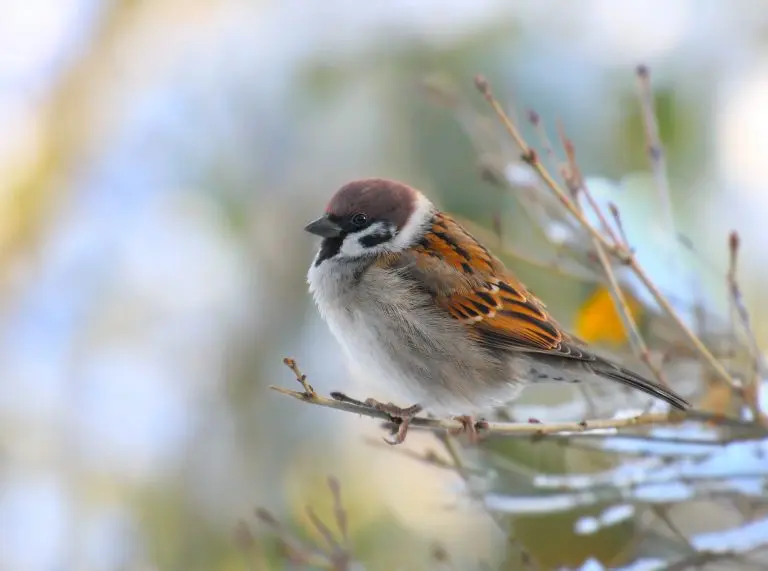
The House Sparrow is another introduced species that has done very well and is now one of the most common birds. They have gray and brown heads and white cheeks. Their backs are black and brown, and their bellies are gray.
- Passer domesticus
- Length: 5.9-6.7 in (15-17 cm)
- Weight: 0.9-1.1 oz (27-30 g)
- Wingspan: 7.5-9.8 in (19-25 cm)
House Sparrows live in the US and Southern Canada all year.
You can find them near houses and buildings, and they can be pretty tame, and they may even eat out of your hand.
House Sparrows eat mostly grain and seed as well as discarded food. They can be considered a pest because they are non-native, but they are found in backyards even if you do not feed them.
House Sparrow Song:
Attract House Sparrows to your backyard feeders with most kinds of birdseed, including millet, corn, and sunflower seeds.
16. Red-breasted Nuthatch
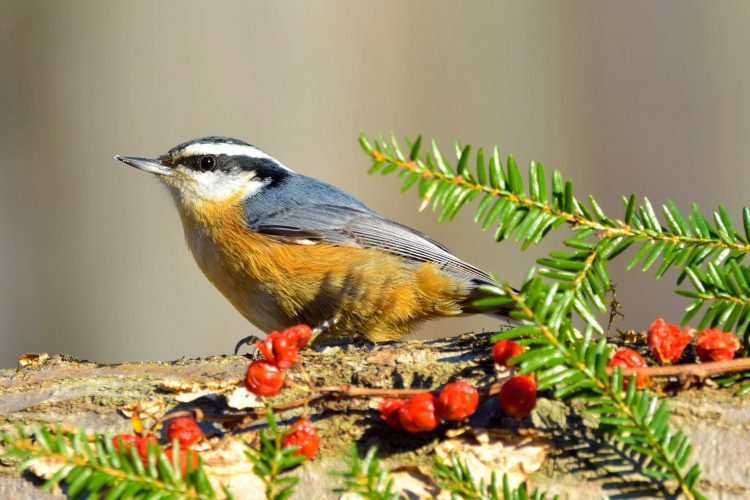
Red-breasted Nuthatches are blue-gray birds with black and white stripes on their heads and a rusty underside.
- Sitta canadensis
- Length: 4.3 in (11 cm)
- Weight: 0.3-0.5 oz (8-13 g)
- Wingspan: 7.1-7.9 in (18-20 cm)
Red-breasted Nuthatches remain all year in northeastern and western states, Alaska and Canada but may move south in winter if cone crops are poor.
You can find Red-breasted Nuthatches in coniferous woods foraging for cones, and they also visit backyard feeders.
Red-breasted Nuthatch Call:
Attract Red-breasted Nuthatches to your backyard with black oil sunflower seeds, suet feeders, peanuts, and mealworms.
17. Mallard
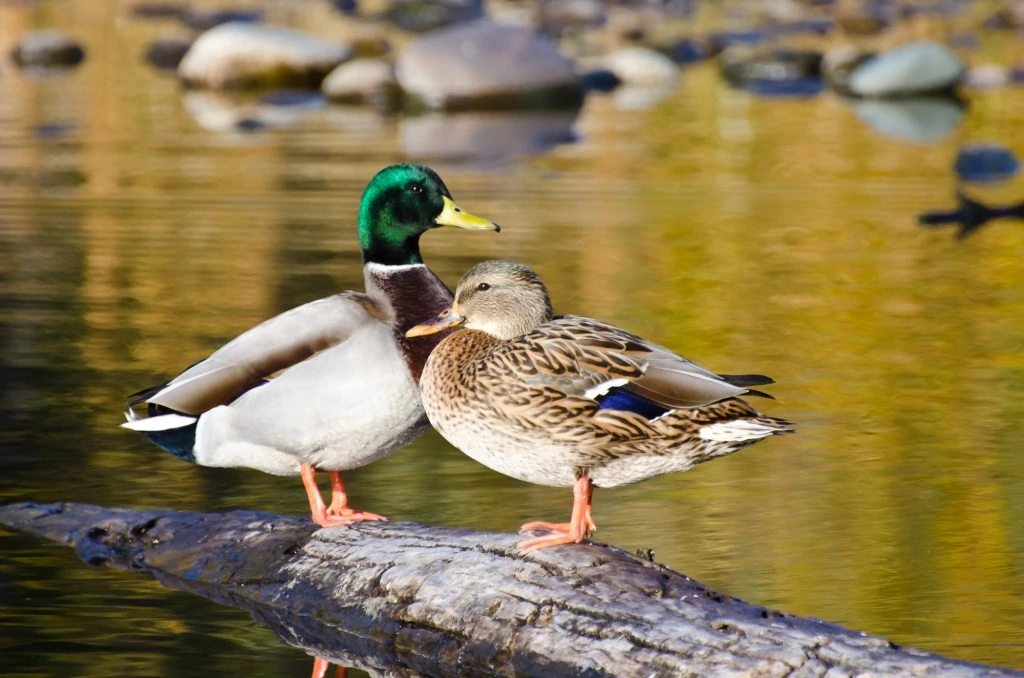
Mallards are large ducks, and the males have striking green heads. They also have bright yellow bills and gray bodies with brown breasts and black towards the tail. They have a curl of tail feathers and a blue patch on the wings bordered with white which is called a speculum.
Females and juveniles are mottled brown with orange bills but still have the blue speculum.
- Anas platyrhynchos
- Length: 19.7 – 25.6 in (50 – 65 cm)
- Weight: 35.3 – 45.9 oz (1000 – 1300 g)
- Wingspan: 32.3 – 37.4 in (82 – 95 cm)
Mallards remain all year in most of the lower 48 and the western coast of Canada and Alaska. Those that breed in Canada and Alaska head south to the southern United States and northern Mexico.
Mallards are one of the most commonly spotted and recognizable ducks that will happily be fed on ponds and rivers. They are dabbling ducks that feed on water plants and do not dive. They are very long-lived, and they have been recorded at 27 years old.
Mallard Calls:
Male Mallards don’t quack, only females do. Instead, the male makes a rasping sound.
Male Mallard Call
Female Mallard Call
Fun Fact: Most domesticated ducks are descended from Mallards, and they have been hunted and bred for food.
18. American Tree Sparrow
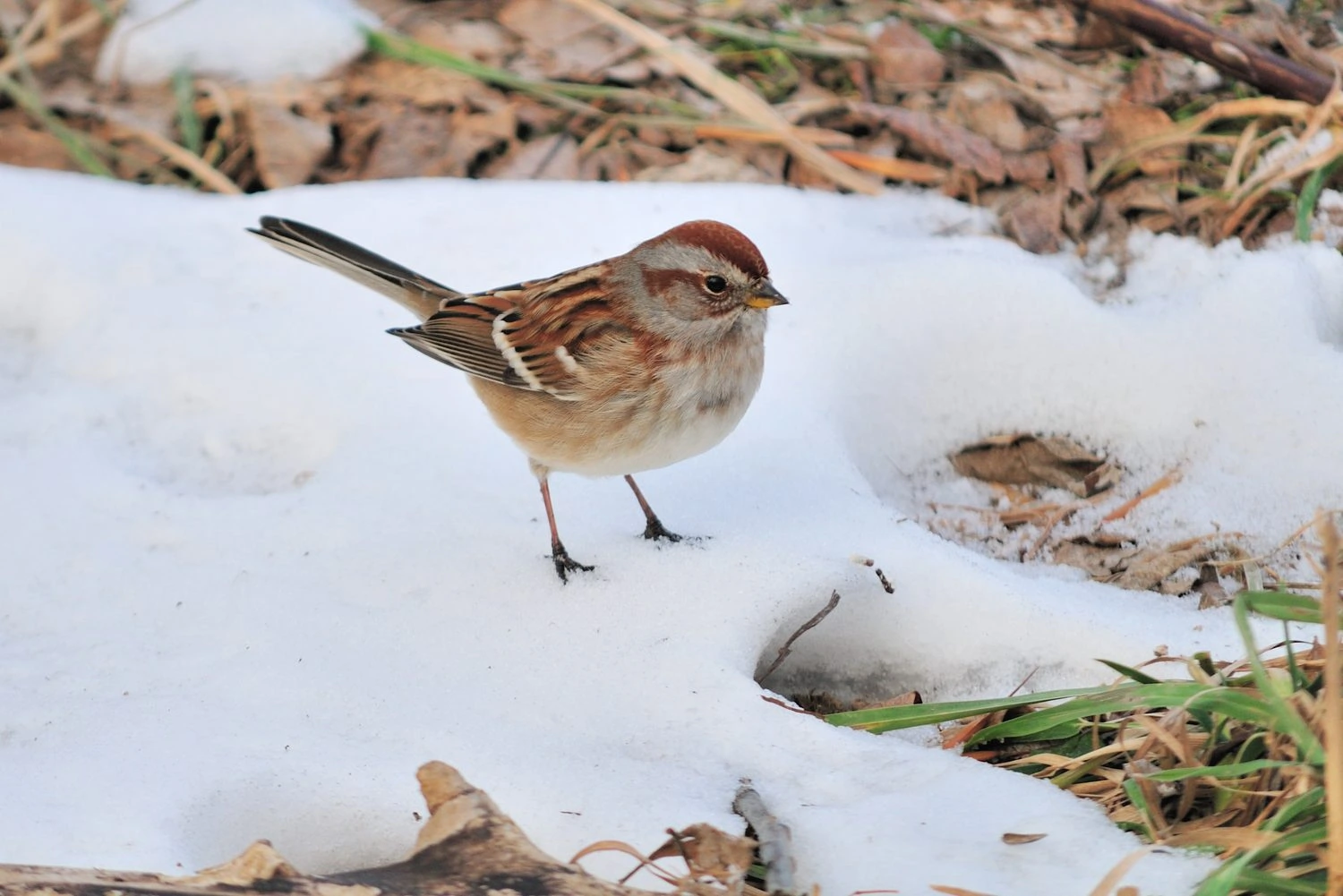
- Spizelloides arborea
- Length: 5.5 in (14 cm)
- Weight: 0.5-1.0 oz (13-28 g)
- Wingspan: 9.4 in (24 cm)
19. Pine Grosbeak
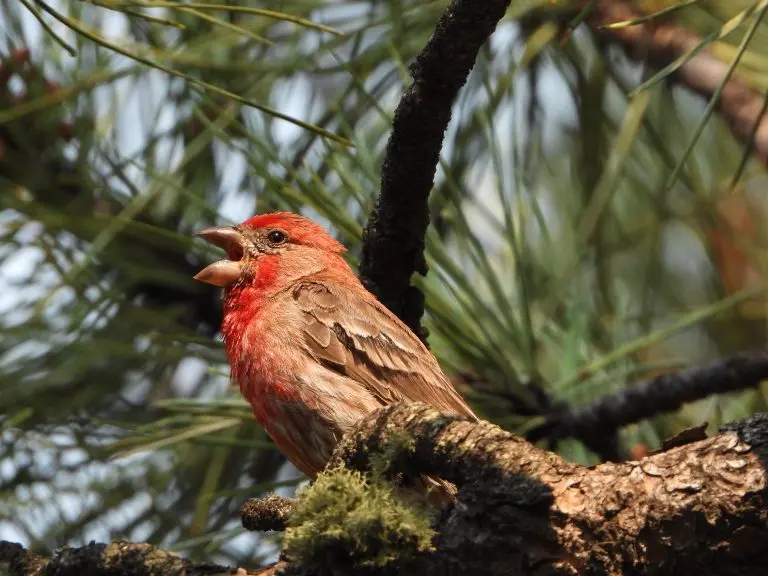
Pine Grosbeaks males are red birds with gray on the wings and tail and two white wingbars. Females are gray with dull orange heads and rumps. They are large for finches and relatively slow.
- Pinicola enucleator
- Length: 7.9-9.8 in (20-25 cm)
- Weight: 2.01 oz (57 g)
- Wingspan: 13.0 in (33 cm)
Pine Grosbeaks are mostly found in Canada, but some can be spotted along the US border, the mountainous west, and the Sierra Nevada in California.
You can find Pine Grosbeaks in forests of pine, spruce, and fir, feeding on seeds, fruit, and buds from these trees. They will also eat some insects in the summer.
Pine Grosbeak Call:
Attract Pine Grosbeaks to your backyards with black oil sunflower seed feeders or suet feeders.
Fun Fact: Pine Grosbeaks are aptly named. Their scientific name, “Pinicola,” is Latin for “pine dweller.”
20. Evening Grosbeak
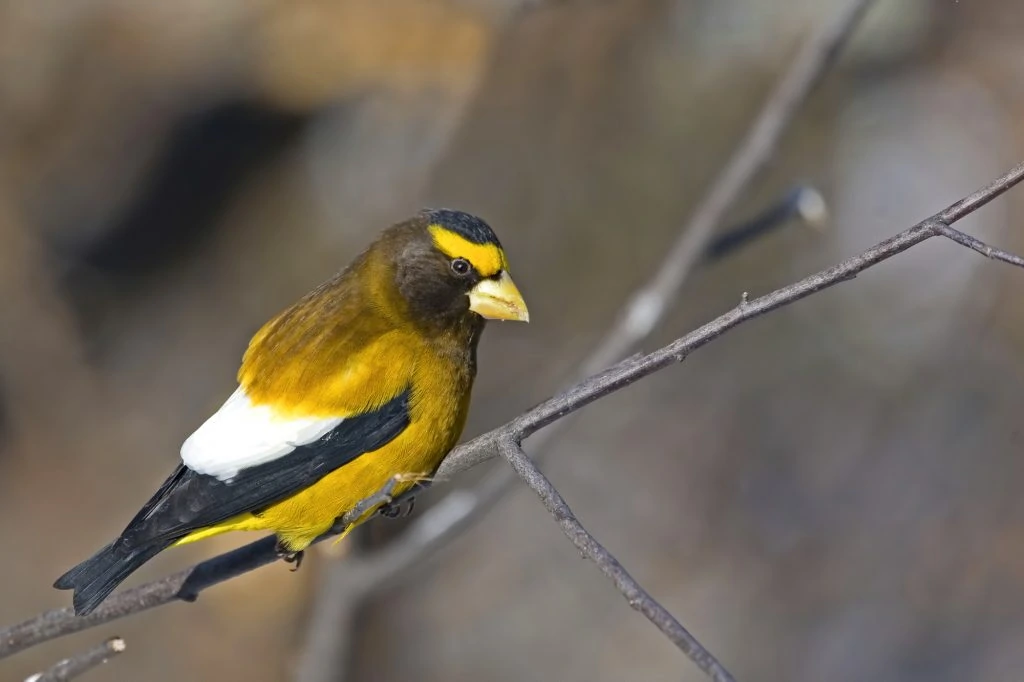
Evening Grosbeaks are chunky birds with big bills and a striking yellow and black pattern. Adult males have a bright yellow stripe over their eyes, making them look fierce. Their heads are black, with gray necks, and their chest and belly are yellow. They also have a white patch on their wings.
Females and juvenile males have greenish bills, mostly gray bodies, black and white wings, and a yellow tinge to the neck.
- Hesperiphona vespertina
- Length: 16 to 22 cm (6.3 to 8.7 in)
- Weight: 38.7 to 86.1 g (1.37 to 3.04 oz)
- Wingspan: 30 to 36 cm (12 to 14 in)
Evening Grosbeaks remain all year in southern Canada and down the west coast to northern California. However, when cone crops are poor, they will migrate south to most US states.
You can find Evening Grosbeaks in forests and mountain regions. During the winter, they’re often attracted to bird feeders in backyards, most often because it’s an easy food supply.
Evening Grosbeaks naturally feed on flower buds during spring; insect larvae from treetops during the summer; and in the winter, they flock to backyard feeders or feast on seeds, berries, and small fruit.
Evening Grosbeak Song:
Attract Evening Grosbeaks to your backyard during winter with sunflower seeds, berries, and maple buds.
Fun Fact: Evening Grosbeaks have such powerful bills that they can crush seeds that are too hard to open for other smaller birds, so these birds hang around to eat whatever is left behind.
21. Snow Bunting
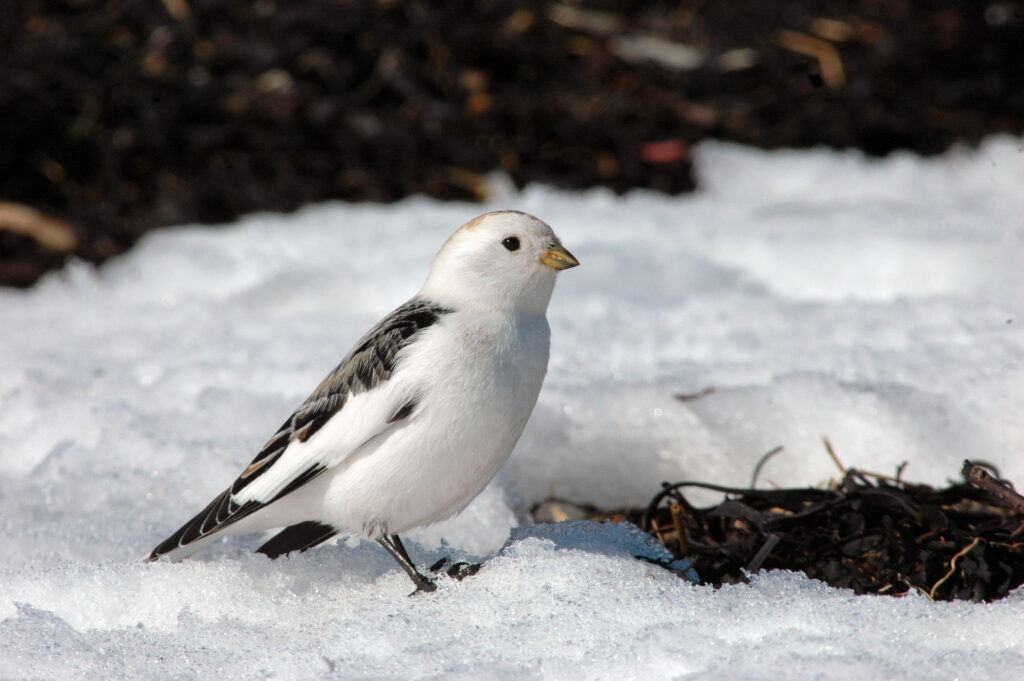
Snow Buntings are medium-sized, gregarious songbirds that inhabit the high Arctic.
Breeding adult males are all white except for black on their backs and wings. Breeding adult females are streaked brown on the back and pale underneath.
Non-breeding male and female Snow Buntings are quite similar with streaked backs, white undersides, and brown patches on their heads. However, non-breeding female Snow Buntings have a stronger reddish coloring than males.
Juvenile Snow Buntings are mostly gray everywhere with dark wings and lighter gray bellies.
- Plectrophenax nivalis
- Length: 6 – 7 in (15 – 17 cm)
- Weight: 1 – 2 oz (28 – 50 g)
- Wingspan: 12 – 14 in (32 – 38 cm)
Snow Buntings breed in Alaska and northern Canada before migrating to southern Canada and the United States for winter. They are also found in western Europe and eastern Russia.
You can find Snow Buntings in rocky habitats in the Arctic during summer. They will also be around areas rich in vegetation like meadows and those places with lichens. In the winter, they may be hard to find because they blend so well in their surroundings, particularly in barren fields.
Snow Buntings usually forage for weeds and seeds on the ground or collect them from flowering plants. They also occasionally eat insects and small crustaceans when near the coast.
Snow Bunting Calls:
Nests of Snow Buntings are hidden in rocky crevices in boulder fields. Females line the nest with moss, grass, feathers, and fur to keep the eggs warm.
She will lay up to seven eggs and will stay on the nest for the whole incubation period of ten to fifteen days. The male’s job is to feed his partner as she cannot leave the nest.
Fun Fact: Unlike other songbirds, Snow Buntings’ feathers do not molt and change color by rubbing the brown tips of the feathers to reveal the white feathers below.
22. Great Black-backed Gull
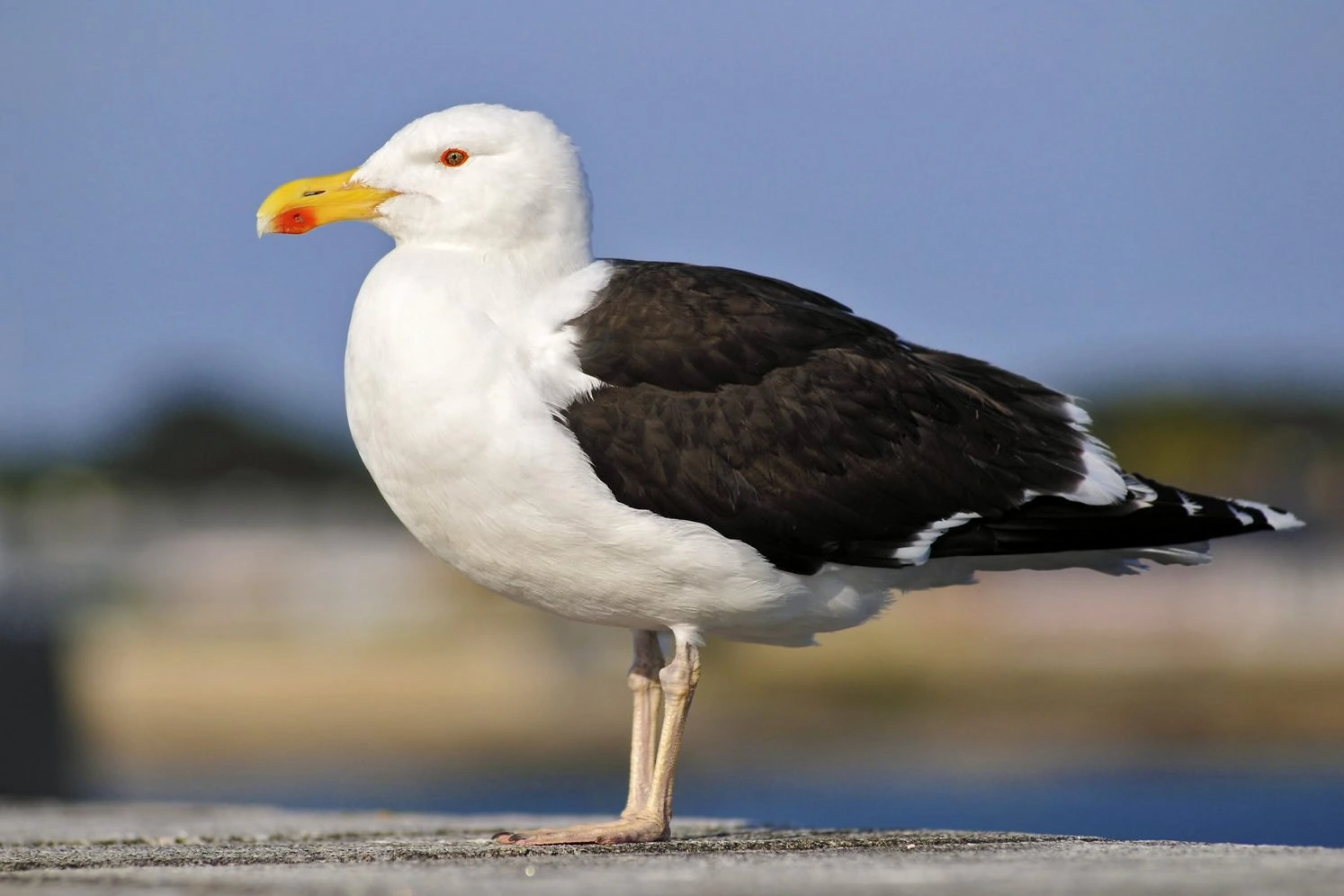
Great Black-backed Gulls are recognized as the world’s largest gulls and the only large gulls with black coloration on their wings and backs in the North Atlantic.
They have white heads and underparts, yellow eyes rimmed with red, large, yellow bills with a red spot, and pink legs.
Juveniles take four years to reach their mature form. During their first winter, they are streaked with gray-brown.
- Larus marinus
- Length: 25 – 31 in (64 – 79 cm)
- Weight: 64 oz (1814 g)
- Wingspan: 60 – 65 in (152 – 165 cm)
You can find Great Black-backed Gulls in many coastal environments like rocky and sandy beaches and estuaries. They also move further inland where there are large bodies of water like lakes, ponds, and rivers. They are also often seen at refuse dumps along the coast and even inland.
The primary food of Great Black-backed Gulls is fish which the snatch from near the surface of the water. However, Great Black-backed gulls are opportunistic feeders and will eat anything they can swallow. Among these, they eat squid, crabs, starfish, crustaceans, and mollusks.
They are very predatory and will target seabird eggs, nestlings, and fledglings. They will also hunt adult birds smaller than them like ducks, eiders, and cormorants. They will pursue them to exhaustion and continuously stab them with their bill. They will also steal food from other birds.
Great Black-backed Gull Calls
Fun Fact: Great Black-backed Gulls are known for having long lives. The oldest wild Great Black-backed Gull that has been recorded is 27.1 years.
23. House Finch
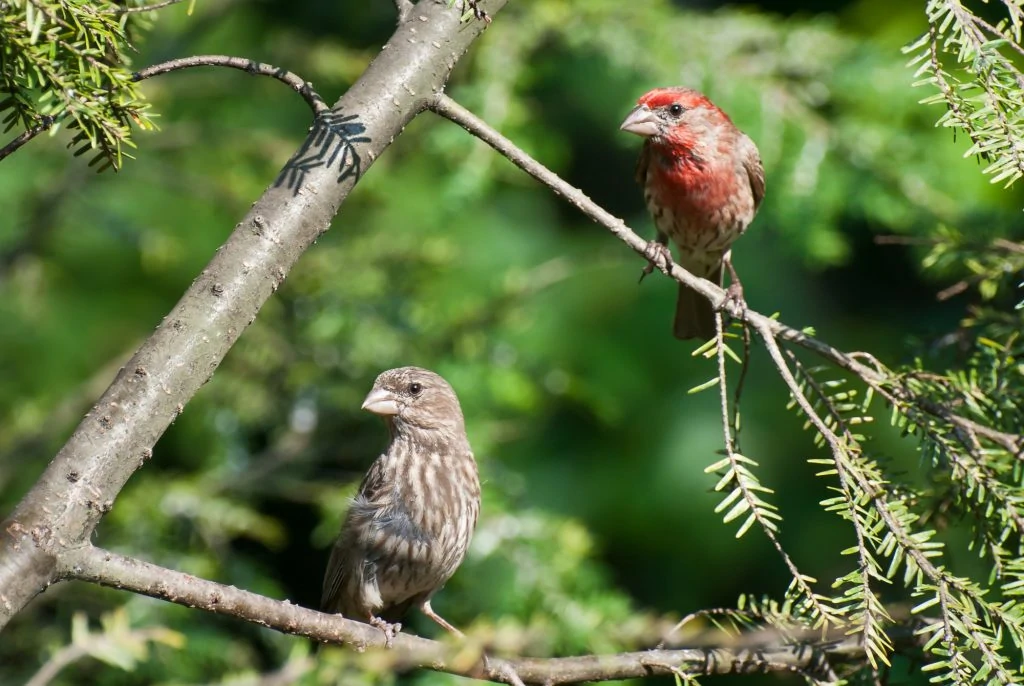
House Finches males have a red head and breast, and the rest of their bodies are mainly brown-streaked. Females are brown-streaked all over.
- Haemorhous mexicanus
- Length: 5.1-5.5 in (13-14 cm)
- Weight: 0.6-0.9 oz (16-27 g)
- Wingspan: 7.9-9.8 in (20-25 cm)
Originally only in western US states, House Finches were introduced to eastern US states and have done very well, even pushing out the Purple Finch.
They can be found in parks, farms, forest edges, and backyard feeders in noisy groups that are hard to miss.
House Finch Song:
House Finch Call:
Attract House Finches to backyard feeders with black oil sunflower seeds or nyjer seeds in tube feeders or platform feeders.
24. American Robin
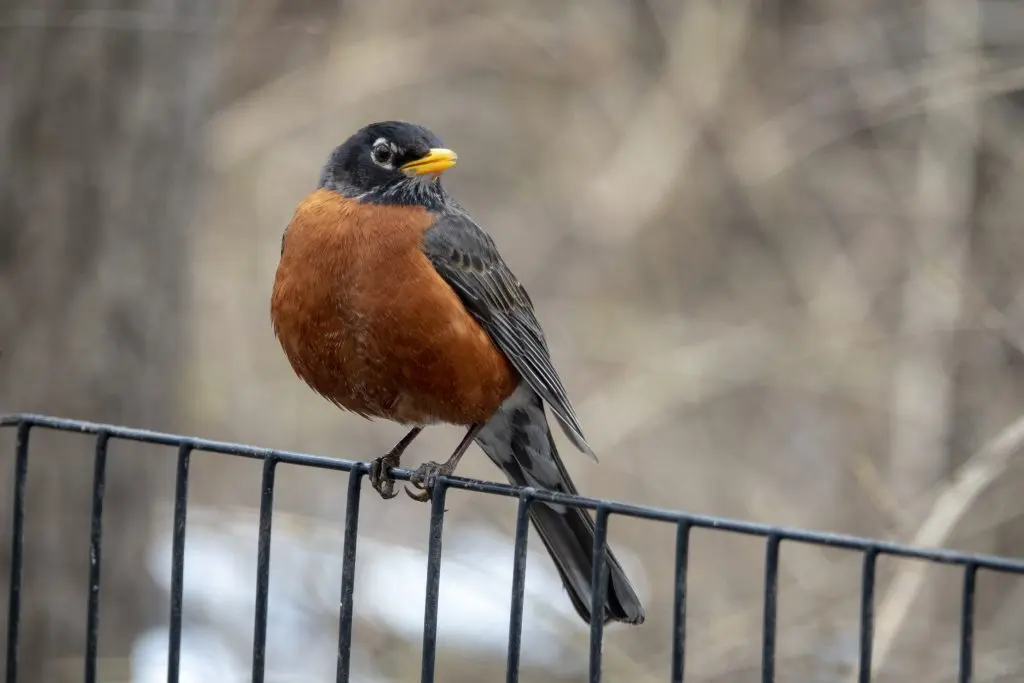
American Robins are a common sight on lawns eating earthworms. They have black heads and backs with red or orange breasts. They tend to roost in trees in winter, so you are more likely to see them in your backyard from spring.
- Turdus migratorius
- Length: 7.9-11.0 in (20-28 cm)
- Weight: 2.7-3.0 oz (77-85 g)
- Wingspan: 12.2-15.8 in (31-40 cm)
American Robins are residents in the lower 48 and the coast of Western Canada and Alaska. Those that breed in Canada and inland Alaska move south for the winter.
American Robins can be found in many habitats, from woodlands, forests, and mountains to fields, parks, and lawns. They eat earthworms, insects, snails, and fruit.
American Robin Song:
American Robin Call:
Attract American Robins to your backyard with sunflower seeds, suet and peanut hearts, fruit, and mealworms. Platform feeders are best or food scattered on the ground. Also, try planting some native plants that produce berries, such as juniper, sumac, hawthorn, and dogwood.
25. Common Merganser
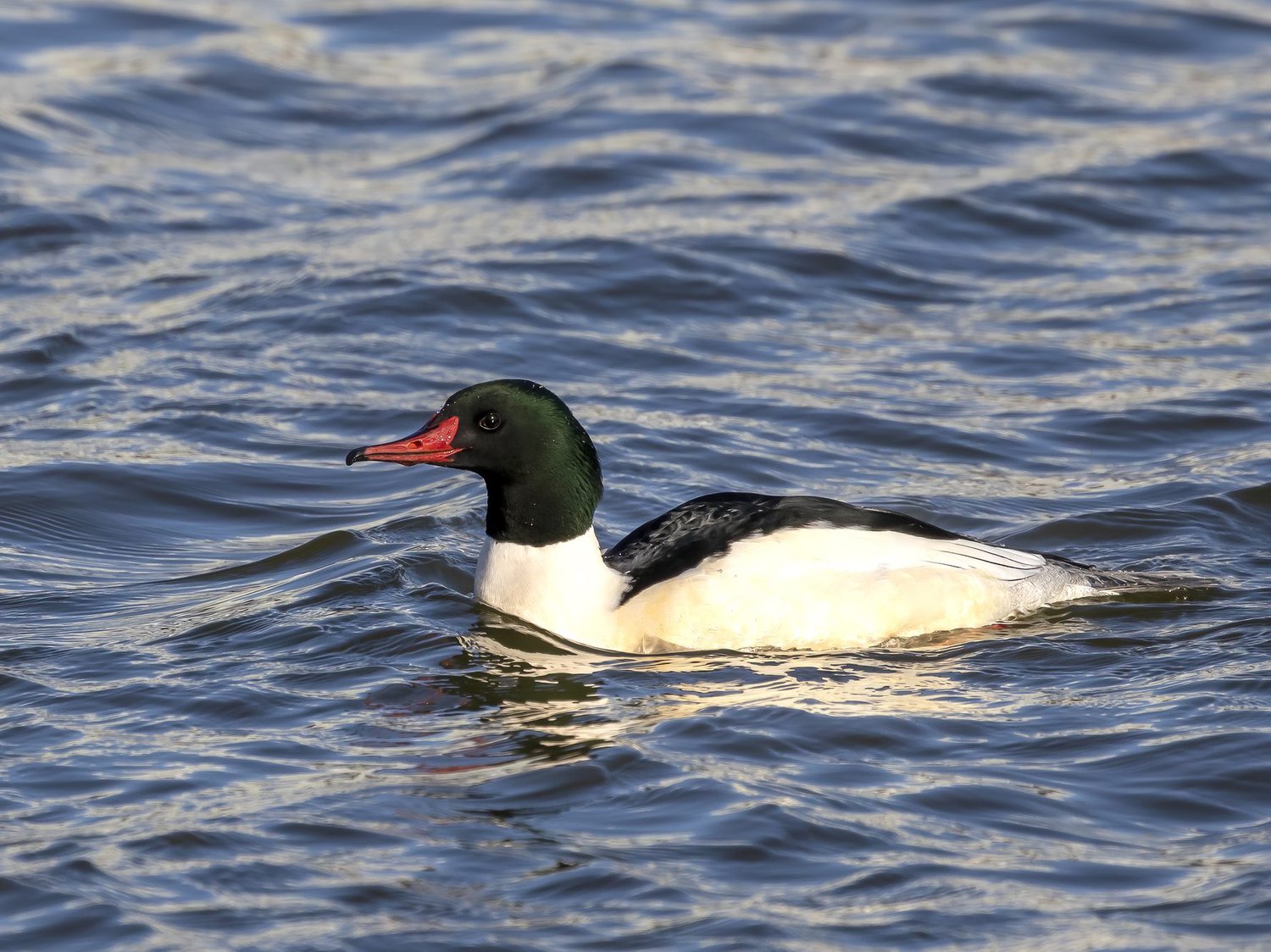
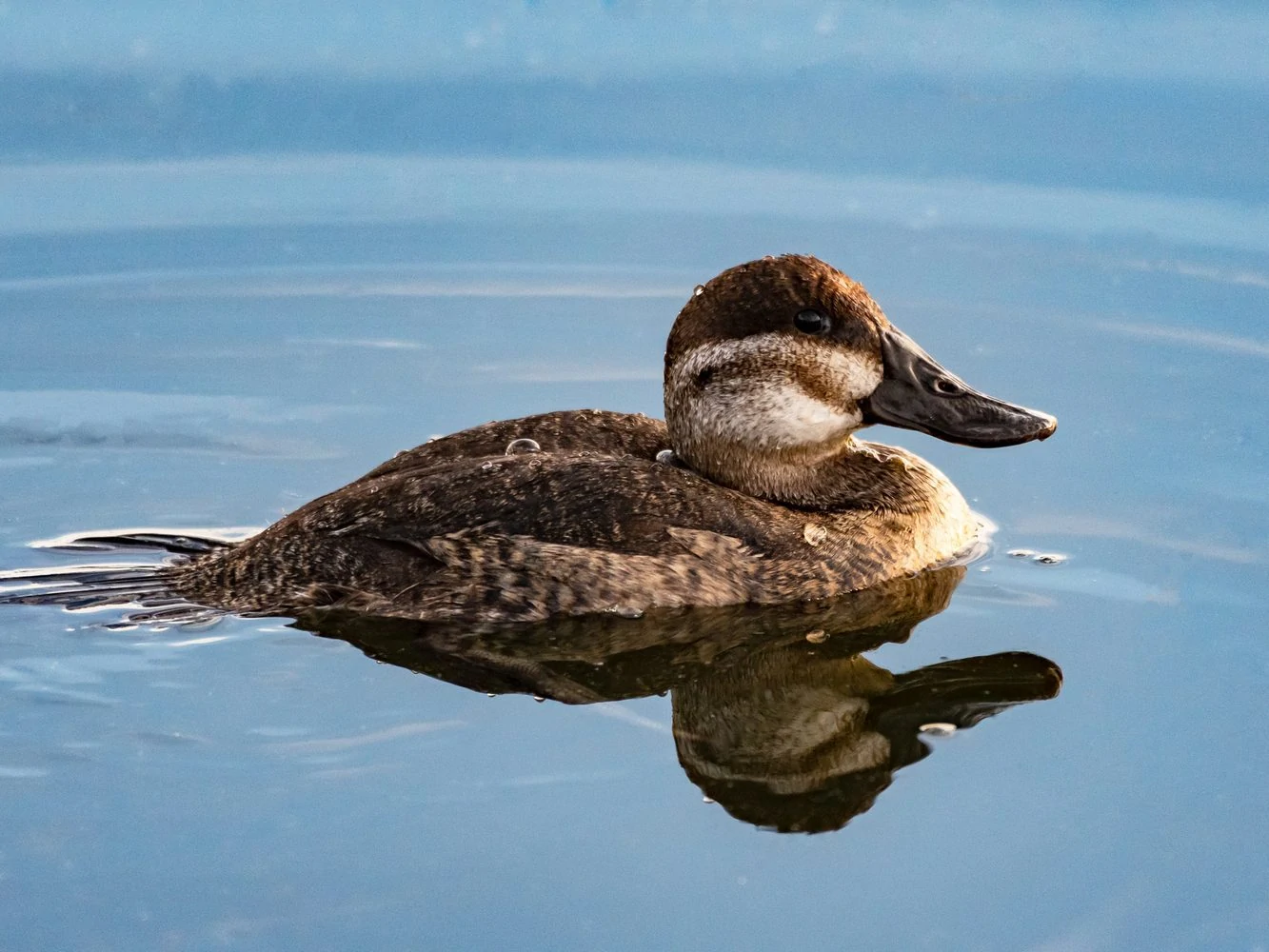
Male Common Mergansers are simple-patterned birds but striking nonetheless. They have black heads with a glossy green sheen, dark eyes, bright-red, long, serrated bills, white bodies, and black backs. While they do have a crest, it’s not often visible.
Females have a more prominent reddish-brown crest. They have the same red, serrated bill as the males. They also have a white chin patch, and their breast and bellies are white, their backs are gray. Juveniles resemble females.
- Mergus merganser
- Length: 22 – 27 in (56 – 69 cm)
- Weight: 60.8 oz (1723 g)
- Wingspan: 31 – 37 in (79 – 94 cm)
Common Mergansers breed in Canada and migrate to the US. Some remain all year in northeastern and northwestern US states.
You can find Common Mergansers in freshwater lakes and ponds. They are also found in small rivers and shallow shorelines and even sitting on rocks in the middle of a stream. While they prefer freshwater habitats, they sometimes visit saltwater regions too, like coastal estuaries and harbors.
Common Mergansers are diving ducks, and they love to eat fish, particularly the adults. Their serrated bills make it easy for them to capture and hold these fish as well as mussels, crustaceans, and other aquatic creatures. Gulls often follow them when hunting to steal the fish from them.
Common Merganser Calls: They are usually fairly quiet, but Male Common Mergansers give alarm calls, and females make a series of grunting calls to their young.
Male Common Merganser call
Female Common Merganser call
Fun Fact: Common Mergansers are also called “sawbills,” “fish ducks,” or “goosanders.”
Winter vs Summer Birds Quebec
There are some birds that stay all year in Quebec but many migrate in or out in the spring and fall. These lists give you the most common birds recorded in checklists by bird watchers in summer or winter on ebird.
Winter Birds Quebec:
Black-capped Chickadee 63.34%
American Crow 41.37%
Blue Jay 34.81%
Downy Woodpecker 32.69%
Hairy Woodpecker 29.17%
European Starling 28.55%
Mourning Dove 26.32%
White-breasted Nuthatch 25.32%
American Goldfinch 25.30%
Common Raven 23.10%
Dark-eyed Junco 21.08%
Rock Pigeon 20.16%
Common Redpoll 18.93%
Northern Cardinal 18.70%
House Sparrow 16.93%
Summer Birds Quebec:
American Robin 56.66%
Song Sparrow 56.38%
American Crow 55.66%
American Goldfinch 54.85%
Black-capped Chickadee 42.76%
Red-eyed Vireo 39.33%
Cedar Waxwing 38.11%
Ring-billed Gull 37.80%
Common Grackle 36.09%
Red-winged Blackbird 35.80%
White-throated Sparrow 29.71%
Chipping Sparrow 29.59%
Mallard 29.57%
Common Yellowthroat 28.73%
Blue Jay 27.87%

